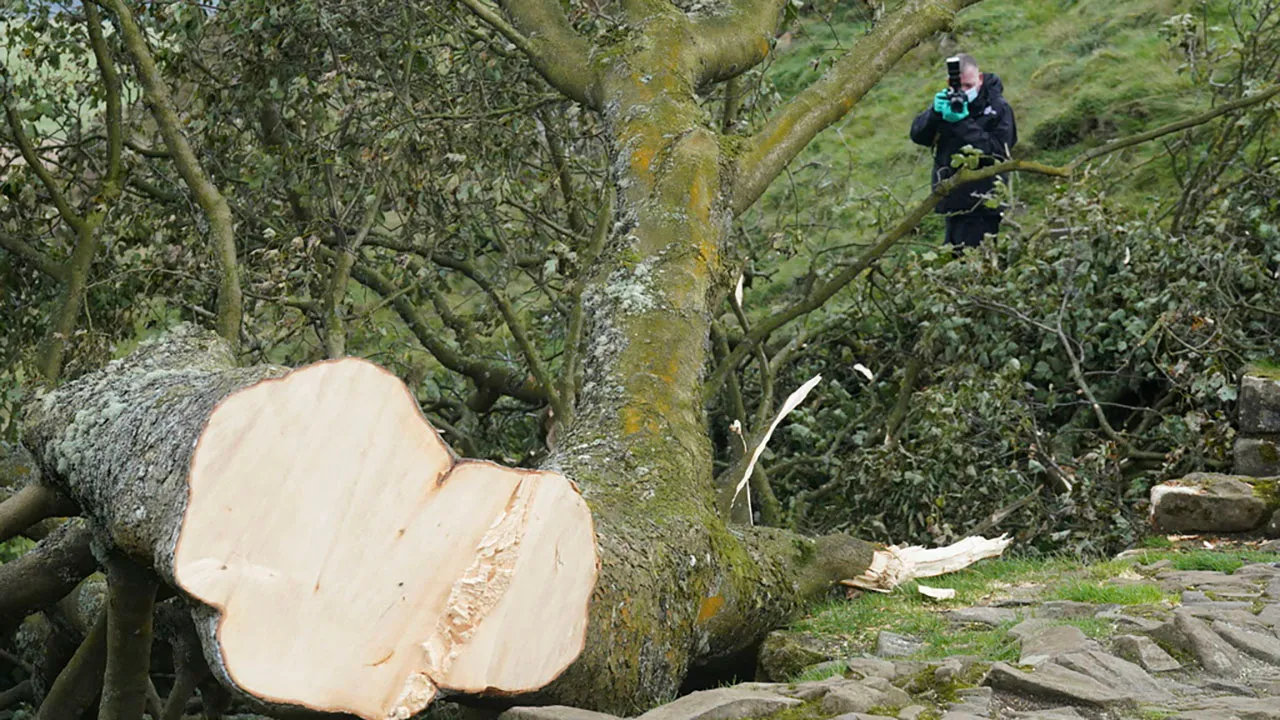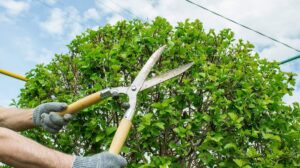When a large tree on your property poses a risk—perhaps it’s weakened by disease, its invasive roots threaten your home’s foundation, or it’s been severely damaged by weather—it may become necessary to have it removed. Removal costs for a tree that’s over 60 feet tall generally fall between $425 and $1,400, but can vary based on several factors.
Tree Removal Cost Calculator
Size of the Tree
| Tree Size | Average Cost |
|---|---|
| Up to 30 feet | $150–$450 |
| 30–60 feet | $450–$1,200 |
| 60–80 feet | $800–$1,500 |
| Over 80 feet | $1,000–$2,000 |
Type of trees
| Type of Tree | Average Removal Cost |
|---|---|
| Oak | $200–$2,000 |
| Japanese Knotweed | $2,000–$10,000 |
| Aspen | $1,000–$1,800 |
| Pine | $250–$1,500 |
| Palm | $650–$1,500 |
| Maple | $250–$2,000 |
| Ash | $250–$1,800 |
| Cedar | $250–$1,500 |
Factors Influencing Cost
- Tree Size: Height and diameter are crucial; larger trees require more labor and machinery, raising the cost.
- Tree Condition: Trees that are diseased or storm-damaged are often more unstable and complicated to remove safely, thus costing more.
- Wood Type: The hardness of the wood affects how difficult the tree is to cut through. For example, oak trees, known for their sturdy wood, may cost anywhere from $250 to $2,500 to remove, whereas softer woods like pine might cost between $200 and $1,600.
- Accessibility: Easily accessible trees will cost less to remove than those surrounded by structures or power lines.
- Risk Factors: Proximity to power lines or buildings can increase danger and cost.
- Emergency Removal
Cost Breakdown
- Labor: The main expense in tree removal is labor, which covers cutting the tree, sectioning the trunk, and disposing of branches. This cost compensates for the contractors’ specialized skills and equipment.
- Permits: Some localities require a permit to remove trees, which could incur additional fees. It’s best to check with your local government beforehand.
- Tips for Managing Costs and Safety
- Regular Maintenance: Keep your trees in good shape by regular pruning and removing any that are dead or diseased. This minimizes the risk of emergencies.
- Insurance: Your homeowner’s insurance may cover part of the cost of tree removal, especially if it poses a risk to your home. It’s worth checking your policy details.
- Local Regulations: Understand your responsibilities by checking with your city or town hall about who handles trees on public property or right-of-ways.
- Repurposing Wood: If the tree is healthy, ask your contractor to cut it into logs for your fireplace, which could be more economical than buying firewood.
- By staying proactive with tree care and understanding the factors that affect removal costs, you can make informed decisions that ensure your property remains both safe and beautiful.”
- If a tree needs to be removed immediately to prevent damage, costs can spike to between $450 and $3,000 depending on the urgency and risk involved.
- Additional Services: Many tree care companies offer comprehensive services including debris cleanup, stump removal, chipping, wood splitting, or even tree transplanting. Check what’s included with your quote.
Oak Tree Removal Cost Calculator Guide
Removing an oak tree can be a necessary but significant investment. This guide covers the average costs, the removal process, safety considerations, and government guidelines. It also highlights the U.S. city with the largest area of oak trees.
Average Cost of Oak Tree Removal
The cost of oak tree removal varies depending on several factors including the tree’s size, location, and accessibility. Here’s a general breakdown:
- Small Oak Tree (Under 30 feet): $200 – $400
- Medium Oak Tree (30 to 60 feet): $400 – $800
- Large Oak Tree (Over 60 feet): $800 – $1,500
Oak Tree Removal Process and Safety Guidelines
Process of Oak Tree Removal
Removing an oak tree involves several steps that must be carried out with precision and care to ensure safety and compliance with local regulations. Here’s a detailed look at the process:
- Initial Consultation and Assessment:
- Arborist Review: A certified arborist inspects the tree to assess its health, stability, and the complexity of the removal process.
- Risk Assessment: Potential hazards to nearby structures, power lines, and public areas are evaluated.
- Obtaining Necessary Permits:
- Local Regulations: Check with local government agencies to obtain any required permits, which may vary depending on the tree’s size and location.
- Preparation of the Site:
- Safety Measures: Set up barriers and signs to ensure that the area around the tree is secure.
- Equipment Setup: Positioning of cranes, chainsaws, wood chippers, and other necessary equipment.
- Tree Felling:
- Cutting Technique: Depending on the tree’s location and size, the arborist will choose between sectional dismantling or straight felling.
- Directional Felling: Techniques are used to control the direction in which the tree falls, minimizing damage to surrounding areas.
- Limbing and Sectioning:
- Removal of Branches: Branches are systematically removed and lowered to the ground using ropes or cranes.
- Cutting into Sections: The trunk is cut into manageable sections, often from the top down to control the fall.
- Debris Removal and Site Cleanup:
- Wood Disposal: Wood can be chipped on-site, removed for sale or donation, or cut into firewood.
- Stump Grinding: The stump is ground down below the soil surface to prevent regrowth and remove tripping hazards.
Safety Guidelines for Oak Tree Removal
Ensuring the safety of the crew and the public is paramount during the tree removal process. Here are key safety guidelines to follow:
- Use of Personal Protective Equipment (PPE):
- Head Protection: Helmets to protect from falling debris.
- Eye and Face Protection: Safety glasses or face shields.
- Hearing Protection: Earplugs or earmuffs to protect against noise from machinery.
- Hand and Foot Protection: Gloves and sturdy boots.
- Operational Safety:
- Qualified Personnel: Only trained and certified individuals should operate machinery and perform tree removal.
- Equipment Checks: Regular inspection and maintenance of all equipment to ensure they are safe and functional.
- Communication: Use of hand signals or radios to maintain clear communication among team members, especially when visibility is limited.
- Environmental Considerations:
- Wildlife Checks: Inspecting for wildlife habitats in the tree before removal, especially during nesting season.
- Weather Conditions: Avoiding operations during adverse weather conditions, such as high winds or lightning.
- Emergency Procedures:
- First Aid: Ensuring that all team members are trained in basic first aid and CPR.
- Emergency Plan: Establishing a clear plan for handling emergencies, including quick access to medical facilities.
Government Regulations
In the U.S., tree removal is regulated at local and state levels. Common guidelines include:
- Permit Requirements: Many cities require permits for tree removal, especially for large or historic trees.
- Protected Species: Some oak species are protected and cannot be removed without specific permissions.
- Property Lines: Ensure the tree is not on public property or crossing into neighboring properties without consent.
Oak Tree in U.S. City
Austin, Texas is known for its significant oak tree population. The city has extensive urban forestry programs to manage and protect these trees.
| City | Oak Tree Coverage |
|---|---|
| Austin, TX | Extensive |
| Sacramento, CA | Substantial |
| Raleigh, NC | High |
| Tampa, FL | Dense |
| Savannah, GA | Notable |
| New Orleans, LA | Widespread |
| Richmond, VA | Abundant |
| Atlanta, GA | Plentiful |
| Charleston, SC | Prominent |
| Jacksonville, FL | Extensive |
| Minneapolis, MN | Considerable |
Pine Tree Removal Cost Calculator Guide
Removing a pine tree often involves significant costs and requires careful planning and adherence to safety and regulatory standards. This guide provides insights into the average costs associated with pine tree removal, outlines the removal process, discusses safety considerations, and details government guidelines. Additionally, the guide highlights the U.S. city with the largest area of pine trees.
Average Cost of Pine Tree Removal
The cost for removing a pine tree can vary based on its height, health, and location. Below is a typical cost breakdown:
- Small Pine Tree (Under 30 feet): $150 – $300
- Medium Pine Tree (30 to 60 feet): $300 – $600
- Large Pine Tree (Over 60 feet): $600 – $1,200
Process of Pine Tree Removal
The removal of a pine tree is a structured process that includes several key steps:
- Assessment: A professional examines the pine tree for any signs of disease, decay, or structural concerns.
- Preparation: The area around the tree is secured, and necessary equipment is set up.
- Felling: The tree is cut from the base if space allows, or removed in sections if it’s in a confined area.
- Cleanup: The site is cleared of debris, and the tree is disposed of as per local regulations or client preference.
Safety Guidelines
- Personal Protective Equipment (PPE): Essential gear includes helmets, eye protection, gloves, and protective boots.
- Secure Area: Ensure the immediate area is free of bystanders and obstacles.
- Professional Assistance: It’s recommended to hire professionals due to the inherent risks involved in pine tree removal.
Government Regulations
- Permits: Many localities require permits especially for large or protected trees.
- Conservation Laws: Some areas have specific laws protecting certain types of pine trees.
- Boundary Laws: Confirm that the tree does not infringe on public or private boundaries.
Pine Tree Area in the U.S. City
Portland, Oregon stands out for its extensive coverage of pine trees, contributing greatly to the city’s lush, green landscape.
| City | Pine Tree Coverage |
|---|---|
| Portland, OR | Extensive |
| Seattle, WA | Substantial |
| Denver, CO | High |
| Minneapolis, MN | Dense |
| Boise, ID | Notable |
| Burlington, VT | Widespread |
| Missoula, MT | Abundant |
| Flagstaff, AZ | Plentiful |
| Asheville, NC | Prominent |
| Bangor, ME | Extensive |
| Reno, NV | Considerable |
These cities are renowned for their significant pine tree populations, which play a critical role in their urban forest ecosystems by providing essential environmental benefits and enhancing natural beauty.





